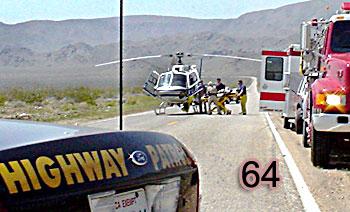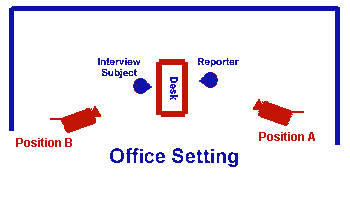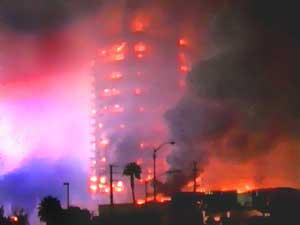|
Module 64 |
Updated: 09/01/2005 |
|
News and Part II
News Sources Broadcast news comes from:
The world's largest newsgathering association, the Associated Press (AP), operates bureaus in 120 U.S. cities and in more than 130 foreign countries-reaching one-third of the world's population. In addition to the AP, there are also a number of smaller wire services, including those operated by large newspapers. At the other end of the scale are blogs -- short for Web logs -- which are now read by about 35% of Internet users and many news organizations. The writers of blogs use web sites to post personal reactions to events, news of the day, rumors, and even their own personal diaries. Photos are also published. After the terrorists bombings in London in July of 2005, thousands of photos of the event were published on personal blog sites. The devastating storm (Katrina) that hit the southeastern U.S. in August, 2005, knocked out operations in many newspapers, and radio and TV stations in the areas affected. During this time many of these media outlets used the Internet to disseminate their news and information. Internet bloggers provided personal accounts, photos, and even messages to the families involved. Blogs, can be highly opinionated and include unsubstantiated information. Even so, the more valued ones are often the source of leads that the mainstream media develop into major stories.
Today, stations have computerized newsrooms and the steady stream of news from these services is electronically written onto a computer hard disk. Using a computer terminal a news editor can quickly scroll through an index of stories that have been electronically stored. Some news editing programs, such as the one illustrated below,
allow you to bring up wire stores from the newsroom computer (shown on the left)
and rewrite it, or copy segments directly into the news script you are writing (shown
on the right). Newsroom automation has reached the point that, in the words of one observer, "Computers have taken over the newsroom." Unless you are computerphobic, this is not bad; in fact, it can result in a much tighter and more sophisticated newscast. Today, newsroom programs are basic to -
Some newsroom systems can be programmed to switch video and
audio sources to correspond to programmed cues in the teleprompter text. |
|
Television stations affiliated with a network and O-and-O stations (those owned and operated by a network) receive daily afternoon and evening satellite news feeds provided by network reporters and affiliated TV stations. Since most of these stories are not used on the network's nightly news, they make good regional, national, and international segments for local newscasts. Independent
stations (those not affiliated with a network) have television news services
they can Whatever the source, the news feeds are recorded for review by the local TV news producer or editor. Stories selected for broadcast are normally saved to a video server or assembled on videotapes and "rolled into" the local news as needed. Regional, national, or even international stories can often be developed from a local perspective. As examples, a major event that takes place in a foreign country can elicit reactions from local people of the same nationality; a crime wave in an adjoining county may cause local people to react; or a shakeup in a New York company may impact employees or related businesses in the station's area. Balance between local, regional, national, and international stories must be considered. Plus, you need to consider the important element of visual variety, which in this case involves a balance between ENG segments and stories that are simply read on-camera with supporting graphics. Although the anchor point for most newscasts is a TV studio, TV audiences like the visual variety and authenticity associated with news segments done outside the studio. Newscasts are now routinely being anchored from foreign countries that dominate the night's news coverage.
For better or worse, interviews are
the basic staple of news and documentaries. You could start out by lighting and micing the set for the "A" and "B" camera positions at the same time. However, for a short interview it's easier and takes less equipment to first light and mic camera position "A." Then after you get all of your A-roll footage, move the camera to position "B," mic the reporter, and move your lights to the appropriate position for this (reverse) angle. In the latter case the camera is first set up in position "A" and focused on the interview subject. The reporter asks all of his or her questions and the responses are recorded on what we've called an "A-roll." Note that both closeups and over-the-shoulder shots are possible from this angle. Then the camera is moved to position "B." With the camera focused on the reporter, all of the questions are then asked over again. This time, however, the interview subject does not answer the questions. In fact, if you can do without the over-the-shoulder shots, the interview subject doesn't even have to be there at all. The reporter simply looks at a "spot on the wall" behind where the person was sitting and re-asks the questions. Remember that a five- to eight-second pause should separate each question, especially if you are using videotape. Reporter reaction shots or "noddies," which we discussed in the editing section, are also recorded from this angle. During editing, the goal will be to condense things as much as possible and still remain true to the subject's answers. When you cut out an unnecessary segment of an answer, you can cover the resulting jump cut with a "noddie," an insert shot, or a cutaway. Often, a reporter's question will be obvious in an answer and you can save time by not using the question. Remember, the faster you can move things along without sacrificing clarity, the better. One of the most difficult aspects of editing an interview, especially when considerable editing and rearranging has to be done, is to achieve smooth linking from one audio segment to the next. This includes preserving the brief pauses that normally occur in conversation. Although editing approaches differ, for interviews most editors first concentrate on audio. Once they have a tightly edited "radio program," they go back and cover the video jump cuts with insert shots, reaction shots, and cutaways. Lighting, audio, and camera placement for the typical office
interview setup is explained in more detail
Most major news stories come up unexpectedly, and it's the reporter/videographer who's prepared to get to the scene of the news first that has the best chance of getting the story on the air first. These kind of "scoops" can rapidly advance a career. First, this means having a check list of essential equipment
drawn up so that you won't forget anything in the rush to get out the door. (There
are many sad stories about crews driving 50 to 100 miles, only to discover they
forgot to bring along an essential piece of equipment.) Have batteries charged and all cameras and equipment ready to transport at a moment's notice. Things happen very fast in a breaking story, so when you arrive on the scene, you should be able to start recording within a few seconds. While you may not get video of the sudden appearance of an ancient sea monster (note simulated photo here), it should mean that you won't "drop the ball" on an important story.
Although we touched on the hazards
of news reporting in the last module, we need to note here that seasoned reporters
Add to this the fact that a crew will be working under its own deadline-related pressures and it becomes obvious that special precautions must be observed. Once reporters leave the arena of local news, risks can become even greater. On the average, one radio, TV, or newspaper reporter is killed somewhere in the world every week. Most of these are killed or imprisoned in countries where there is fear of a free flow of information or it is felt that a particular a story will threaten political or religious control. A moving documentary was recently
aired showing the atrocities Despite repeated denials by the Taliban, widespread instances of torture, rape, amputations, and murder were documented by Saira Shah through the use of a hidden video camera. In a country where women were forced to beg for themselves
and their children because they were prevented from working and even
from going to school,
this woman clearly risk her life to get the footage. As a result, she influenced
world thinking about the Taliban. (A reader to the CyberCollege Forum
has added If you are interested in being a
foreign correspondent, you should rent the film, The highly-rated film, which is based on a recent true story, makes use of actual news footage to very dramatically (Note: and very graphically) show what war correspondents face. Finally, if you ever need some ideas
for news stories or documentaries that can make a positive difference, consider
It Takes Commitment and Courage When we see news and documentary stories from hostile and dangerous locations, we seldom stop to think that in capturing the story a videographer took the same or greater personal risks than the reporter that you see on camera. (The reporters are often not even on the scene; they add their narration later in relative safety.) Many of the stories, such as the one that Saira Shah did that we mentioned above, have had a profound impact on viewers. The images of bodies floating in rivers in the Philippines broadcast in a PBS documentary started a chain of events that eventually toppled the corrupt dictator of a country. In 2004, Andy Levine, penetrated high security areas and used a camera hidden in his eyeglasses to document forced prostitution for a moving and disturbing documentary entitled, The Day My God Died. In each of these cases, and in many more like them, courageous videographers were willing to risk it all for what they saw as a greater good. Internet Resources:
|


 subscribe
to-the largest being the Cable News Network (CNN).
subscribe
to-the largest being the Cable News Network (CNN). Let's take a look at a typical office interview situation.
Let's take a look at a typical office interview situation.
 know that people can go into a kind of "shock fog" during crises, and cannot always
be counted on to respond rationally.
know that people can go into a kind of "shock fog" during crises, and cannot always
be counted on to respond rationally. being
committed on the people of Afghanistan by the Taliban, the radical religious group
reportedly behind the 9/11 terrorists acts on the East Coast of the U.S.
being
committed on the people of Afghanistan by the Taliban, the radical religious group
reportedly behind the 9/11 terrorists acts on the East Coast of the U.S. Welcome
to Sarajevo, starring Stephen Dillane and Woody Harrelson.
Welcome
to Sarajevo, starring Stephen Dillane and Woody Harrelson.